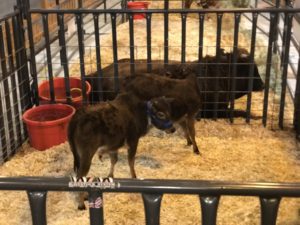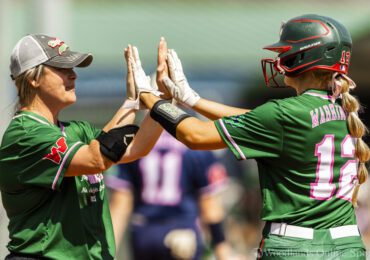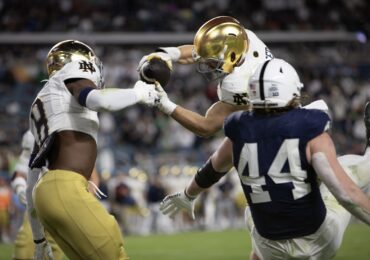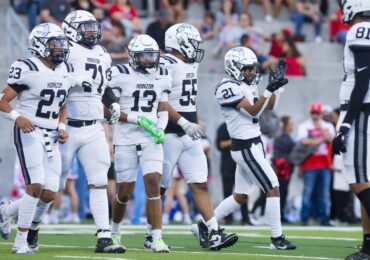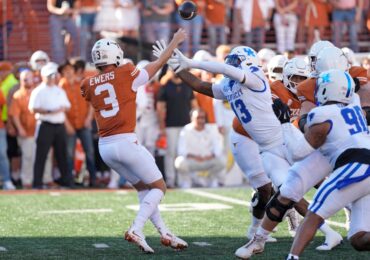Andre Odums Sr. and Jr. Look at cattle that may be ready for Houston Livestock Show
Champions Row
Located near the main Arena in the Reliant Center, Champions Row houses the Grand and Reserve Grand Champions of each junior market show. See the champion barrows, lambs, goats and steers in one location. Prior to housing the champion livestock, Champions Row will display livestock that is representative of ideal specimens of each species.
Airline Tickets
Houston Livestock Show junior champions are awarded three airline tickets.
- each of the breed champions in the Junior Breeding Beef Heifer Show
- Supreme Champion Gilt
- Reserve Supreme Champion Gilt
- Supreme Champion Ewe
- Reserve Supreme Champion Ewe
Junior Show
The Houston Livestock Show™ draws thousands of Texas 4-H and FFA exhibitors to compete at the world’s largest livestock show. These students bring various species of livestock — from rabbits and poultry to goats and steers — each hoping to take home the coveted title of Houston Champion. Each exhibitor works several months to prepare for competition among the finest junior livestock the state of Texas has to offer. Participants are between the ages of 9 and 18 (students in the 3rd grade become eligible on their 8th birthday), are Texas residents and are members of a Texas 4-H Club or FFA Chapter.
Breeding Livestock
Scramble Heifers
 Everyone knows a story of a tremendous catch in the calf scramble at RodeoHouston®. Those lucky Texas 4-H and FFA members return to the next year’s Houston Livestock Show™ to compete in the Junior Scramble Heifer Show.
Everyone knows a story of a tremendous catch in the calf scramble at RodeoHouston®. Those lucky Texas 4-H and FFA members return to the next year’s Houston Livestock Show™ to compete in the Junior Scramble Heifer Show.
Breeding Beef Heifers
Breeding beef heifers compete over a three day period in nearly 20 different breeds. All heifers are judged in the categories of Heifer Calves, Junior Heifers and Senior Heifers, depending on their birth date. Each breed is judged on their breed’s desired characteristics, and each division’s overall winners return to compete in the Supreme Champion Drive.
Breeding Gilts
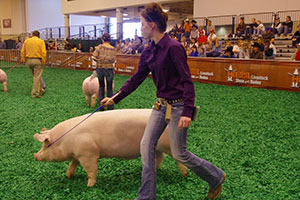 A gilt is a young female swine about 6 months old. Gilts are divided into pre-set age divisions within their respective breeds, and the Champions compete in the Supreme Champion drive.
A gilt is a young female swine about 6 months old. Gilts are divided into pre-set age divisions within their respective breeds, and the Champions compete in the Supreme Champion drive.
Breeding Sheep
More than 10 different breeds compete in the Breeding Sheep Show. Classes are split into ram, ewe and group categories, then broken into age classes. The Supreme Champion Ewe is chosen from the winners of all breed classes.
Dairy Cattle
 Exhibitors of Dairy Cattle show in traditional “milkman” uniforms of white shirt and pants and a black tie. Udder encompasses the largest portion of the scorecard, while the feet and legs, dairy character, body capacity, and frame also are taken into account. The cattle are judged in classes depending on their age and in group classes.
Exhibitors of Dairy Cattle show in traditional “milkman” uniforms of white shirt and pants and a black tie. Udder encompasses the largest portion of the scorecard, while the feet and legs, dairy character, body capacity, and frame also are taken into account. The cattle are judged in classes depending on their age and in group classes.
Market Livestock
Market Barrows
Barrows are shown by breed and divided into weight divisions. Each breed champion competes for the Junior Market Barrow Champion title.
Market Broilers
 Pens of three broilers fill part of Reliant Arena in hopes of becoming the Champion Junior Market Broiler Pen.
Pens of three broilers fill part of Reliant Arena in hopes of becoming the Champion Junior Market Broiler Pen.
Market Goats
Exhibitors show their animals in weight divisions. The Grand and Reserve Grand Champions from each division compete for the title of Grand Champion Junior Market Goat.
Market Lambs
 Junior Market Lambs are judged in several categories, including Fine Wool, Fine Wool Cross, Medium Wool, and Southdown. Each category is broken into weight divisions. The animals are judged on separate sets of qualifications based on their category. Champion Market Lambs compete for high premiums and championship titles.
Junior Market Lambs are judged in several categories, including Fine Wool, Fine Wool Cross, Medium Wool, and Southdown. Each category is broken into weight divisions. The animals are judged on separate sets of qualifications based on their category. Champion Market Lambs compete for high premiums and championship titles.
Market Steers
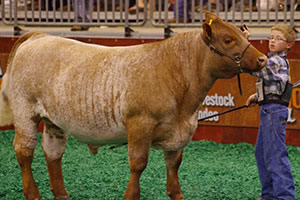 Steers compete within their breed, and each breeds’ champion is selected based on the desired traits of the breed. Champion steers in each breed travel to Reliant Stadium for the “Championship Drive,” where the Grand Champion Steer is selected in front of thousands of RodeoHouston fans.
Steers compete within their breed, and each breeds’ champion is selected based on the desired traits of the breed. Champion steers in each breed travel to Reliant Stadium for the “Championship Drive,” where the Grand Champion Steer is selected in front of thousands of RodeoHouston fans.
Market Turkeys
After months of raising these large birds, the competition comes down to judging in Reliant Arena. After judging the toms (males) and hens (females), the championship title is awarded to the turkey that possesses the most desirable traits.
Contests
Agricultural Mechanics Project Show
This Show highlights the many talents of Texas 4-H and FFA members. These individuals build gates, hay haulers, trailers and more, all on display in Reliant Center – an awe-inspiring display of amazing workable works of art.
Agricultural Science Fair
The Agriculture Science Fair recognizes students studying the application of agricultural scientific principles and emerging technologies in agricultural enterprises. Categories a student may enter include: Animal Systems, Environmental Services/Natural Resource Systems, Food Products and Processing Systems, Plant Systems, Power/Structural/Technical Systems, and Social Systems. The Agricultural Science Fair is open to all students in the Houston area who meet qualifications, as well as members of Texas 4-H and FFA.
Beef Quiz Bowl
National 4-H and FFA Invitational Beef Quiz Bowl Contest
In this tournament-style contest, teams are tested on their knowledge of beef. Each state can enter up to three teams in the competition. Contestants must be 4-H or FFA members and be between the ages of 14 and 19.
Calf Scramble
A favorite event at R odeoHouston, these exhibitors actually receive quite the award. Successfully catching a calf may be surprisingly the easiest part. Each of the students who catch a calf is awarded a $1,500 certificate to purchase a registered beef heifer or a market steer. Raising and showing this animal becomes a yearlong project as the scrambler sees to the grooming, feeding and care of the animal. The exhibitor returns to the Houston Livestock Show the following year for a special competition.
Commercial Steer Feeding and Management
This contest is a practical beef production program. Emphasis is placed on feeding economy. Each entry consists of a pen of three steers. Along with raising a pen of steers, exhibitors are required to complete a quiz, oral interview, and submit a completed record book of all feedings and weights from the previous months. Additional scoring is based on each steer’s quality and yield grade, the cost per pound gained, the average daily gain, and the feed conversion production. Steers are sold at a special sale.
Judging
Decision-making skills learned at a young age play a vital role in meeting the challenges that life offers. The Houston Livestock Show and Rodeo hosts nine judging contests that provide junior high, high school and college students an opportunity to establish a solid foundation for cultivating and practicing these skills.
- 4-H and FFA Dairy Judging
- 4-H and FFA Horse Judging
- 4-H and FFA Livestock Judging
Intercollegiate Livestock Judging
These contests require the students to match their skills in selecting the best quality livestock of various species against placings of an officially qualified livestock judge. Each contestant is asked to place, in numerical order from highest to lowest quality, each of four animals in several classes. Scores are determined by a point value based on the difference between animals.The top 20 high-scoring individuals participating in either the 4-H and FFA livestock judging contests or in the 4-H and FFA dairy judging contest receive calf purchase certificates to be used toward the purchase of quality beef or dairy heifers, or market steers. These contest winners, along with their animals, then become part of the regular calf scramble program.
The intercollegiate judging contests are conducted in the same manner as the 4-H and FFA contests with one exception: the college students are required to give oral reasons, which are graded as well, explaining how they placed each animal in the class.
4-H and FFA Floriculture
4-H and FFA Nursury Landscape
This contest is separated into three parts. In part one, contestants identify 50 different specimens, which may consist of any part of a plant. In part two, contestants place six classes, greenery or container grown plants. In part three, contestants are given a general knowledge exam, consisting 50 multiple choice questions.
4-H and FFA Meats Judging
Intercollegiate Meat Judging
This contest allows contestants to apply their industry knowledge and judging skills. Teams of four contestants judge beef, pork and lamb carcasses. Written reasons pertaining to the quality and yield differences must be given.
 4-H and FFA Poultry Judging
4-H and FFA Poultry Judging
Contestants place poultry classes, including one dozen cartons of chicken eggs, past production egg-type hens (students rank live hens according to estimated past egg production based on the coloring of pigmentation of the hen’s egg), turkey carcasses, and pre-cooked, breaded chicken patties. The contest includes a written examination, poultry carcass parts for identification and chicken eggs for interior quality grading.
4-H and FFA Wildlife Habitat Evaluation
This contest tests students’ knowledge on identifying potential problems that can occur in wildlife habitats. Contestants work independently on food identification, habitat interpretation using aerial photography and on-site habitat management recommendations. Senior division contestants also give independent oral reasons and complete a rural or urban wildlife management plan.
4-H and FFA Wool Judging
Intercollegiate Wool And Mohair Judging
The contest involves placing breed and commercial fleeces and classifying 15 fleeces of wool into various grades and spinning counts. Special attention is paid to the wool’s staple length and yield, and the highest yielding fleeces are ranked first, followed in order by those with a lesser yield. Additionally, contestants will determine the correct grades for a class of 30 mohair samples.
Range and Pasture Plant Identification
This contest involves identification of a minimum of 50 grass samples and range plants. Their value, either beneficial or detrimental to livestock and wildlife, is determined and recorded by each contestant.
Public Speaking
The Public Speaking Contest is open to all students in the Houston area who meet qualifications, as well as members of Texas 4-H and FFA. Speakers present talked on one division topic — Western heritage, natural resources, animal science, plant science, agribusiness, agricultural policy or agriscience.
Tractor Technician
 Each three-member team in this contest must locate and correct five deliberately placed malfunctions in diesel-fueled tractors. Each team is given two minutes to review a service work order, and, 25 minutes to complete the task. If successful, a designated driver then starts the tractor and drives it around a predetermined course. Each participant must complete a 100-question written exam and an evaluation of 20 tractor and implement components.
Each three-member team in this contest must locate and correct five deliberately placed malfunctions in diesel-fueled tractors. Each team is given two minutes to review a service work order, and, 25 minutes to complete the task. If successful, a designated driver then starts the tractor and drives it around a predetermined course. Each participant must complete a 100-question written exam and an evaluation of 20 tractor and implement components.
Youth Show
The Houston Livestock Show hosts several shows within the youth livestock division. In order to compete, the exhibitor must be enrolled in a public or private, elementary or secondary school in Texas. Exhibitor must be at least in the third grade or 8 years old, but not older than 19 years old on the day judging begins.
Cattle
 This youth show highlights specialty cattle like the Dexter and Texas Longhorn breeds. Classes are judged based on sex and age. Champions are based on physical correctness based on the breeds’ standards. Each breeds’ animal must be registered with the national registry prior to the show date and comply with the associations’ and Show’s guidelines.The Texas Longhorn show also features a showmanship category, in which exhibitors, broken into age divisions, are chosen on their ability to exhibit their animal in the ring. The animal’s structural correctness is not a factor in the judge’s decision in this class.
This youth show highlights specialty cattle like the Dexter and Texas Longhorn breeds. Classes are judged based on sex and age. Champions are based on physical correctness based on the breeds’ standards. Each breeds’ animal must be registered with the national registry prior to the show date and comply with the associations’ and Show’s guidelines.The Texas Longhorn show also features a showmanship category, in which exhibitors, broken into age divisions, are chosen on their ability to exhibit their animal in the ring. The animal’s structural correctness is not a factor in the judge’s decision in this class.
Dairy and Boer Goats
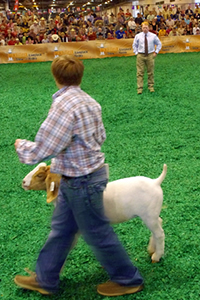 The Goat show is shown in two divisions — Dairy and Boer. The classes are shown in Senior Doe, including “Best Senior Doe of Show,” and in Junior classes of Kids and Does, including “Best Junior Doe in Show” and Grand Champion Doe.Boer goats are shown in Percentage Blood and Fullblood Divisions, junior and senior age divisions in both, and split in separate sex shows of boers and does. There is also an overall Grand Champion Goat awarded.
The Goat show is shown in two divisions — Dairy and Boer. The classes are shown in Senior Doe, including “Best Senior Doe of Show,” and in Junior classes of Kids and Does, including “Best Junior Doe in Show” and Grand Champion Doe.Boer goats are shown in Percentage Blood and Fullblood Divisions, junior and senior age divisions in both, and split in separate sex shows of boers and does. There is also an overall Grand Champion Goat awarded.
Llamas and Alpacas
 Youth show in categories of Junior, Intermediate and Senior in the Obstacle, Public Relations (for the animal that participates in community activities), Pack classes (simulates the conditions and obstacles actually encountered when packing llamas on the trail), and Youth Showmanship (judged on the ability to show his/her animal to its best advantage at halter and the exhibitor’s basic skills in fitting, grooming, following directions and style of presenting the animal to judge for evaluation). The animal’s conformation is not considered.Youth have the opportunity to participate in a special program, “Lloan-A-Llama,” open to youth 5 years old and in kindergarten through 18 years of age who do not own or lease a llama or alpaca. The Houston Livestock Show and Rodeo Llama Committee provides the animals. This contest is limited to those youth, who are not showing livestock.
Youth show in categories of Junior, Intermediate and Senior in the Obstacle, Public Relations (for the animal that participates in community activities), Pack classes (simulates the conditions and obstacles actually encountered when packing llamas on the trail), and Youth Showmanship (judged on the ability to show his/her animal to its best advantage at halter and the exhibitor’s basic skills in fitting, grooming, following directions and style of presenting the animal to judge for evaluation). The animal’s conformation is not considered.Youth have the opportunity to participate in a special program, “Lloan-A-Llama,” open to youth 5 years old and in kindergarten through 18 years of age who do not own or lease a llama or alpaca. The Houston Livestock Show and Rodeo Llama Committee provides the animals. This contest is limited to those youth, who are not showing livestock.
Breeding Rabbits
In the Rabbit show, along with the Best of Breed classes, junior and intermediate youth exhibitors must also complete a written test; while senior exhibitors must complete a written test and judge a class of five rabbits. There is a First Timer’s Contest, for contestants who have not competed in a previous Youth Rabbit Judging Contest. There also is a Team Judging Contest. Each team consists of four youth exhibitors.
Meat Pen RabbitsOpen Show
From across the U.S. and Texas, exhibitors come to the Houston Livestock Show each spring to vie for a championship title. Agriculture is big business in the U.S., and big business is driven through competition. Along with the honor of being named Houston Champion, the winning exhibitor receives publicity and accolades that further the development of their breeding program. Only the best of the best walk away winners at Houston!
Beef Cattle
 From Angus to Santa Gertrudis, and Brahman to Hereford, beef cattle are the driving force of Texas agriculture. From across the U.S., breeders of top quality beef cattle come to the Houston Livestock Show to compete with both bulls and heifers split into age divisions. Junior, Yearling and Senior age divisions name champions.
From Angus to Santa Gertrudis, and Brahman to Hereford, beef cattle are the driving force of Texas agriculture. From across the U.S., breeders of top quality beef cattle come to the Houston Livestock Show to compete with both bulls and heifers split into age divisions. Junior, Yearling and Senior age divisions name champions.
Dairy Cattle
Exhibitors of Dairy Cattle show in traditional “milkman” uniforms of white shirt and pants and a black tie. Udder encompasses the largest portion of the scorecard, while the feet and legs, dairy character, body capacity, and frame also are taken into account. The cattle are judged in classes depending on their age and in group classes.
Llamas and Alpacas
 Llamas and Alpacas are a crowd favorite! The Alpaca comes in two types, the Huacaya and Suri. Their main difference is their fleece type. The Huacaya has a crimpy fleece, which makes the fleece stand straight out from the body. The Suri has no crimp in its fleece, so it hangs in lock structures. There are also Fleece divisions to judge the correctness of the animals fleece product, as well as Obstacle classes, Public Relations classes (for the animal that participates in community activities) and Pack classes (simulates the conditions and obstacles actually encountered when packing llamas on the trail).
Llamas and Alpacas are a crowd favorite! The Alpaca comes in two types, the Huacaya and Suri. Their main difference is their fleece type. The Huacaya has a crimpy fleece, which makes the fleece stand straight out from the body. The Suri has no crimp in its fleece, so it hangs in lock structures. There are also Fleece divisions to judge the correctness of the animals fleece product, as well as Obstacle classes, Public Relations classes (for the animal that participates in community activities) and Pack classes (simulates the conditions and obstacles actually encountered when packing llamas on the trail).
Rabbits and Cavies
 Several breeds of rabbits compete and are judged in Best of Breed, Best of Opposite Sex of Breed, Best in Show and Best of the Best of Opposites of Sex.Cavies are shown in age and sex classifications of Boar or Sow and Junior, Intermediate and Senior. The classes judged are Best of Breed, Best of Opposite Sex of Breed and Best in Show. Cavies are also shown in a Costume class for best originality of costume.
Several breeds of rabbits compete and are judged in Best of Breed, Best of Opposite Sex of Breed, Best in Show and Best of the Best of Opposites of Sex.Cavies are shown in age and sex classifications of Boar or Sow and Junior, Intermediate and Senior. The classes judged are Best of Breed, Best of Opposite Sex of Breed and Best in Show. Cavies are also shown in a Costume class for best originality of costume.
Sheep and Goats
 Each of the twelve breeds competing in the open sheep show is divided into 14 classes. Classes are broken into age and sex divisions; Ram, Ewe and Lamb are shown at all ages. “Best Pair of Sheep” and “Exhibitors Flock” are shown in groups. “The Best Herdsman” award is given for best overall winning sheep. The Goat show is divided in two divisions — Dairy and Boer. Class schedules, age requirements and premium money are the same for all breeds.
Each of the twelve breeds competing in the open sheep show is divided into 14 classes. Classes are broken into age and sex divisions; Ram, Ewe and Lamb are shown at all ages. “Best Pair of Sheep” and “Exhibitors Flock” are shown in groups. “The Best Herdsman” award is given for best overall winning sheep. The Goat show is divided in two divisions — Dairy and Boer. Class schedules, age requirements and premium money are the same for all breeds.
Sheep Dog Trials
 The Sheep Dog Trials consist of timed tests on the dog’s ability to herd as well as obey its master. Using a series of words and whistles, the handler’s movements are restricted as the dog herds a small group of sheep around obstacles and into a holding pen.
The Sheep Dog Trials consist of timed tests on the dog’s ability to herd as well as obey its master. Using a series of words and whistles, the handler’s movements are restricted as the dog herds a small group of sheep around obstacles and into a holding pen.



